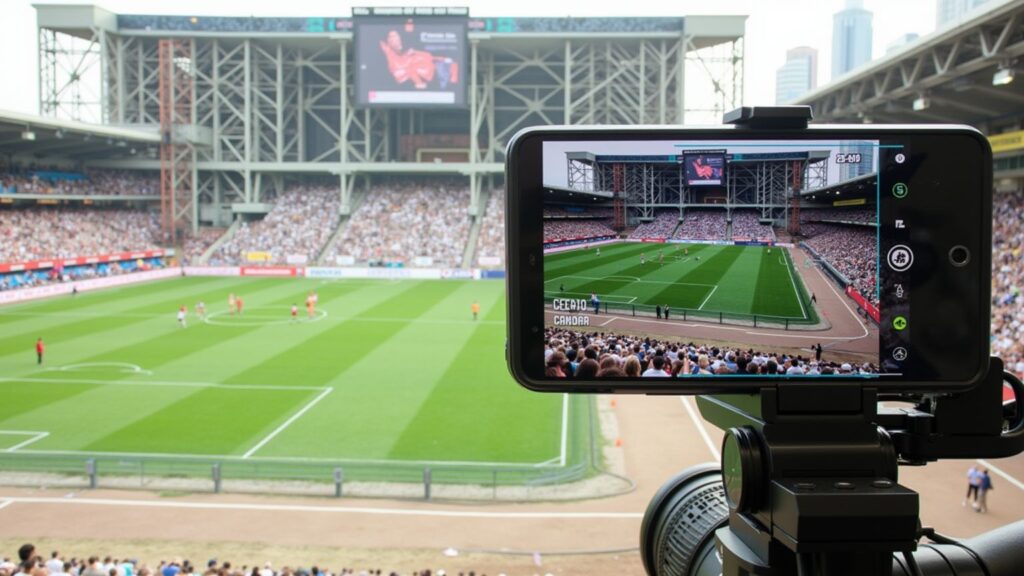The Ultimate Guide to Choosing AI Cameras for Sports
Technology is rewriting the rules with capturing breathtaking moments on the pitch, court, or track. AI cameras for sports are…

Technology is rewriting the rules with capturing breathtaking moments on the pitch, court, or track. AI cameras for sports are innovative devices that combine artificial intelligence with the art of photography and videography.
These cameras are changing the game of AI in sports, offering advanced features like automated tracking, real-time analytics, and high-quality video production with no need of an entire crew.
But why should you care about AI cameras, and how can they benefit your next sports event?
Whether you’re a coach striving to break down player performances, a content creator looking to engage fans with dynamic game footage, or simply an enthusiast wanting the best seat in the house from the comfort of your screen, AI cameras have something to offer. They’re making professional-level sports coverage more accessible, efficient, and affordable than ever before.
This guide dives deep into the world of AI cameras tailored for sports. We’ll explore how they work, their diverse benefits, and the considerations to keep in mind when choosing one.
Understanding AI Cameras

What are AI Cameras?
AI cameras are smart, tech-driven devices designed to capture, analyze, and enhance footage automatically using artificial intelligence. These devices can process visual information and react in real time, a capability beyond traditional cameras.
For example, an AI camera used in sports might track a player or follow the ball without any manual input, ensuring that the action is always in frame.
What sets AI cameras apart is their ability to process visual data and learn over time. Many are equipped with features like facial recognition, motion detection, and pattern analysis.
This allows them to not only record but also interpret what’s happening. For sports enthusiasts or professionals, this means smoother live-streaming, clearer game footage, and more precise highlights—all without the need for a skilled camera operator.
AI cameras come in various forms, including handheld models, stationary cameras, and even drones. Each type is tailored for different use cases. Whether you’re capturing a fast-paced soccer match or highlighting a single athlete’s performance, there’s an AI camera designed to meet your needs. In essence, these smart devices blend cutting-edge technology with convenience, providing a new perspective for sports fans, players, and coaches alike.
Benefits of AI Cameras in Sports
AI cameras are revolutionizing the sports industry, offering a range of benefits that both players and fans can enjoy. These smart cameras go beyond simply recording games—they analyze, adapt, and enhance the action in real-time. Whether you’re a coach, an athlete, or just someone who loves the game, AI cameras are paving the way for a more dynamic sports experience.
One of the standout advantages of AI cameras for sports is automated tracking. Unlike traditional cameras that rely on manual panning, AI technology uses machine learning to follow the ball, players, or specific actions. This means you get flawless footage without missed moments, which is especially valuable for fast-paced sports like soccer, basketball, or tennis.
Another major perk is data analytics. Many AI cameras come equipped with features to generate insights, such as player stats, heat maps, or tactical patterns. This gives coaches actionable information to improve team performance or assess individual athletes in detail.

For broadcasters and fans, AI cameras simplify live streaming. Automated editing and framing provide polished, professional-quality footage with minimal effort. Plus, the ability to capture highlights on the fly makes sharing key moments easier than ever.
With reduced operational costs, improved insights, and enhanced accessibility, AI cameras are transforming how we play, coach, and watch sports.
Types of AI Cameras Available
When it comes to AI cameras for sports, you’ll find options suited for a variety of needs and budgets. Understanding the types available is key to finding one that fits your specific requirements. Let’s take a closer look:
1. Fixed AI Cameras: These cameras are mounted in a permanent position, typically in sports arenas or fields. They’re ideal for capturing the entire field of play and are often used for team sports like soccer or basketball. Fixed AI cameras can autonomously track the action, zooming in when necessary without needing a camera operator.
2. Portable AI Cameras: Perfect for versatility, these lightweight cameras can be moved around easily, allowing you to film at various locations. They’re great for coaches, athletes, or teams that travel often. Many of these come with AI-enhanced tracking features so you can focus on the action without manual adjustments.
3. Wearable AI Cameras: If you’re looking for a first-person perspective, wearable AI cameras are the way to go. These can be attached to helmets, jerseys, or even glasses, making them ideal for sports like cycling, skateboarding, or skiing.
4. Drone AI Cameras: Offering a unique aerial vantage point, drones use AI to follow players, zoom in on critical moments, and even avoid obstacles mid-flight. These are popular for dynamic sports such as football or rugby.
With such diverse options, there’s an AI camera designed to meet every filming challenge in sports. Which one suits you best depends on your goals, environment, and budget.
Factors to Consider When Choosing AI Cameras
Budget Considerations
For investing in an AI camera for sports, your budget will likely be the first thing you need to nail down. AI cameras come in a wide range of prices, from high-end professional models to more affordable options for everyday use. Deciding how much you’re willing to spend will help narrow your choices considerably.
If you’re working within a smaller budget, focus on models that deliver essential features, such as auto-tracking, decent video resolution, and basic integration options.
For those with more flexibility, splurging on cameras with advanced functionalities like 4K streaming, multi-camera setups, or powerful machine learning algorithms could be worth the extra expense. Always allocate some of your budget for accessories like tripods, mounts, or extra storage that you may need.
It’s also wise to consider long-term costs. Will you need a subscription for additional features or software updates? Does the device require frequent maintenance or pricey add-ons? Keep these hidden costs in mind as they can add up over time.
Ultimately, finding the perfect balance between price and performance ensures you’re investing in the best option for your needs without breaking the bank.
Budget Considerations
When choosing an AI camera for sports, setting a clear budget is one of the first and most important steps. AI cameras come at various price points, from high-end professional systems to more affordable options. Defining how much you’re willing to spend can help narrow your choices and prevent you from overspending on features you may not need.
Start by assessing your specific requirements.
Are you a casual coach looking for a reliable way to record practice sessions, or are you a professional seeking state-of-the-art technology for live broadcasts? High-end AI cameras often include advanced features like real-time analytics, 4K resolution, and automated tracking, but they come with a premium price tag.
On the other hand, mid-range and budget-friendly options may focus on core functionalities like clear image quality and basic tracking, offering excellent value for smaller teams or hobbyists.
Also, factor in potential additional costs. For instance, some AI cameras might require a subscription for cloud storage or advanced analytics. Others may need extra equipment, like tripods or mobile devices for setup, which can add to your overall expenditure. By considering both upfront and long-term costs, you can choose a camera that strikes the right balance between price and performance.
Camera Features and Specifications
The right features ensure your camera delivers the performance you need for dynamic sports environments.
Start with the resolution. For sports, a camera with at least Full HD (1080p) resolution is recommended. However, if you’re covering fast-paced action or high-stakes games, a 4K camera provides sharper detail and a more immersive viewing experience. Look for cameras with higher frame rates (e.g., 60fps or more) to ensure smooth playback for fast-moving subjects.
Next, consider the AI capabilities. A good sports camera should excel in tracking players, detecting key moments like goals or touchdowns, and even automatically framing the shot. Some AI cameras also provide advanced analytics, such as heat maps to track player movement or performance metrics for post-game review.
Don’t overlook low-light performance. Sports events often take place under varying lighting conditions, so having a camera with excellent night vision or the ability to handle high dynamic range (HDR) can be a game-changer.
Finally, think about portability and durability. Whether you’re on the sidelines or at an outdoor arena, a lightweight, weather-resistant camera is ideal for handling different environments. By balancing these specifications with your specific needs, you’ll ensure you invest in a tool that truly elevates your sports coverage.
Compatibility and Integration
One of the most important factors to consider is its compatibility and ease of integration with your existing equipment and workflows. It’s not just about the camera’s features—it’s about how well it fits into your overall system.
Start by checking if the AI camera is compatible with your preferred video editing software or live-streaming platforms. Many cameras come with proprietary apps or tools, but you’ll want one that works seamlessly with popular platforms like OBS, YouTube, or Twitch. Additionally, ensure the camera supports standard file formats like MP4 or MOV for smooth editing and sharing.
Integration with other hardware, like tripods, monitors, or audio systems, is also worth examining. Does the camera include standard ports like HDMI or USB? Can it connect wirelessly to other devices, or does it require additional adapters? A camera that integrates smoothly with your current setup can save time and money.
Lastly, consider future-proofing. Is the camera compatible with the latest technologies, like 5G connectivity or cloud storage? If the manufacturer regularly updates firmware, this is a good sign that the camera will stay functional with evolving systems.
Finding a well-integrated option ensures hassle-free operation, helping you focus on capturing the action rather than troubleshooting technology.
Top AI Cameras for Sports in the Market
High-end Models
If you’re looking to invest in the crème de la crème of sports AI cameras, high-end models deliver cutting-edge features that redefine the way games are captured and analyzed. These cameras often come with powerful AI capabilities like automatic tracking, advanced motion detection, and detailed video analytics, making them ideal for professional sports organizations and large-scale events.
For example, brands like Pixellot and Spiideo offer premium systems that can autonomously record games, provide real-time analytics, and even generate live-streaming footage. Their sophisticated algorithms ensure every key moment is captured, freeing you from manual operation. These cameras also boast superior resolution, from 4K to even 8K, which means every second of action is displayed with exceptional clarity.
While these high-end solutions offer unparalleled performance, they come at a steep price, often ranging from $5,000 to $20,000+ depending on specific features and required software. They’re best suited for teams or organizations with larger budgets and a strong need for comprehensive, data-driven insights.
Key perks:
If you want to take your sports coverage to the next level, high-end AI cameras are a worthwhile investment for precision and professionalism.
Mid-range Options
Mid-range AI cameras strike an ideal balance between performance and affordability, making them a popular choice for sports enthusiasts, semi-professional teams, and even smaller organizations. These cameras often offer advanced features without the hefty price tag of high-end models, providing excellent value for money.
One standout in this category is the Pixellot Air. Designed for amateur leagues and schools, this camera excels with automated broadcasting features. It records games in HD quality, tracks key moments via AI, and requires little manual control, making it a perfect “set-it-and-forget-it” option.
Another reliable pick is the Veo Cam 2, which boasts 4K resolution, a sleek portable design, and the ability to automatically pan and zoom to follow the action. Its user-friendly interface and cloud integration make sharing and editing highlights easier than ever.
When choosing a mid-range AI camera, consider what features you truly need. Do you prioritize portability for away games, or is seamless integration with social sharing platforms a must-have?
These cameras suit teams and individuals who want to elevate their sports coverage without overextending their budget. By combining practicality and performance, mid-range options provide an adaptable solution for capturing the excitement of every match.
Budget-friendly Choices
If you’re working with a tight budget, don’t worry—you can still find AI cameras for sports that deliver great performance without breaking the bank. Budget-friendly models are ideal for smaller sports clubs, hobbyists, or anyone just getting started with recording and analyzing sports footage.
Here are a few factors to prioritize when shopping for affordable choices:
Some standout budget-friendly AI cameras include:
- Pixio Robot Cameraman: A solid option with automatic zoom and motion tracking, perfect for solo sports practices.
- Veo Start: A beginner-friendly camera with good AI tracking at an entry-level price.
- GoPro Hero 9: While not AI-focused, you can pair it with third-party apps to unlock AI functionality.
Budget models may lack the bells and whistles, but they’ll get the job done—smartly and affordably!
Conclusion
AI cameras have revolutionized the way we experience and engage with sports, offering cutting-edge features that enhance both player performance and fan experience.
From providing automated tracking and analytics to offering customizable options for various sports, these cameras are an invaluable tool for athletes, coaches, and broadcasters alike. Whether you’re seeking high-end models packed with advanced features, reliable mid-range options, or budget-friendly choices, the market has something to suit every need and price point.
When choosing an AI camera, it’s essential to consider factors like your budget, the features and specifications that matter most to your sport, and how well the camera integrates with your existing tools or workflow.
By weighing these aspects carefully, you can make an informed decision and ensure your investment enhances your sports coverage or training sessions.
AI technology in sports cameras is constantly evolving, and by staying informed about industry trends, you’ll always have access to the best tools available. Whether you’re aiming to capture the perfect game-winning moment or analyze gameplay strategies, AI cameras have opened a world of possibilities. The future of sports tracking technology is bright, and embracing these advancements today equips you for even greater achievements tomorrow.
